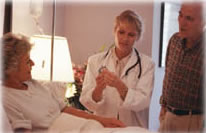


   |
Pemphigus Vulgaris - Causes, Symptoms and Treatment
Definition Pemphigus vulgaris is a rare auto-immune disease of skin. Pemphigus is derived from the Greek word pemphix meaning bubble or blister. Pemphigus describes a group of chronic bullous diseases, originally named by Wichman in 1791. The term pemphigus once included most bullous eruptions of the skin, but diagnostic tests have improved, and bullous diseases have been reclassified. This is an informational page for the patients and their families and it contains links which they may find useful. It does not contain medical advice. Affected individuals have high concentrations of antibodies produced by the immune system. These bind to a specific protein in the skin causing interference with the skin’s normal function. The cells no longer stick together and become separated from each other. Pemphigus is uncommon. It occurs almost exclusively in middle-aged or older people of all races and ethnic groups. About one-half of the cases of pemphigus vulgaris begin with blisters in the mouth, followed by skin blisters. Causes
Symptoms
Treatment
| |
Online Doctor || Teeth Care || Contact Us || Diabetes Care || Cellulite Guide || Chemotherapy || Acne Products ||
|
|
(c) Online-family-doctor.com All rights reserved
Disclaimer: Online-family-doctor.com is an information and educational purposes web site only. It is not intended to treat, diagnose, cure, or prevent any disease. Do not rely upon any of the information provided on this site for medical diagnosis or treatment. Please consult your primary health care provider about any personal health concerns. We will not be liable for any complications, or other medical accidents arising from the use of any information on this site.